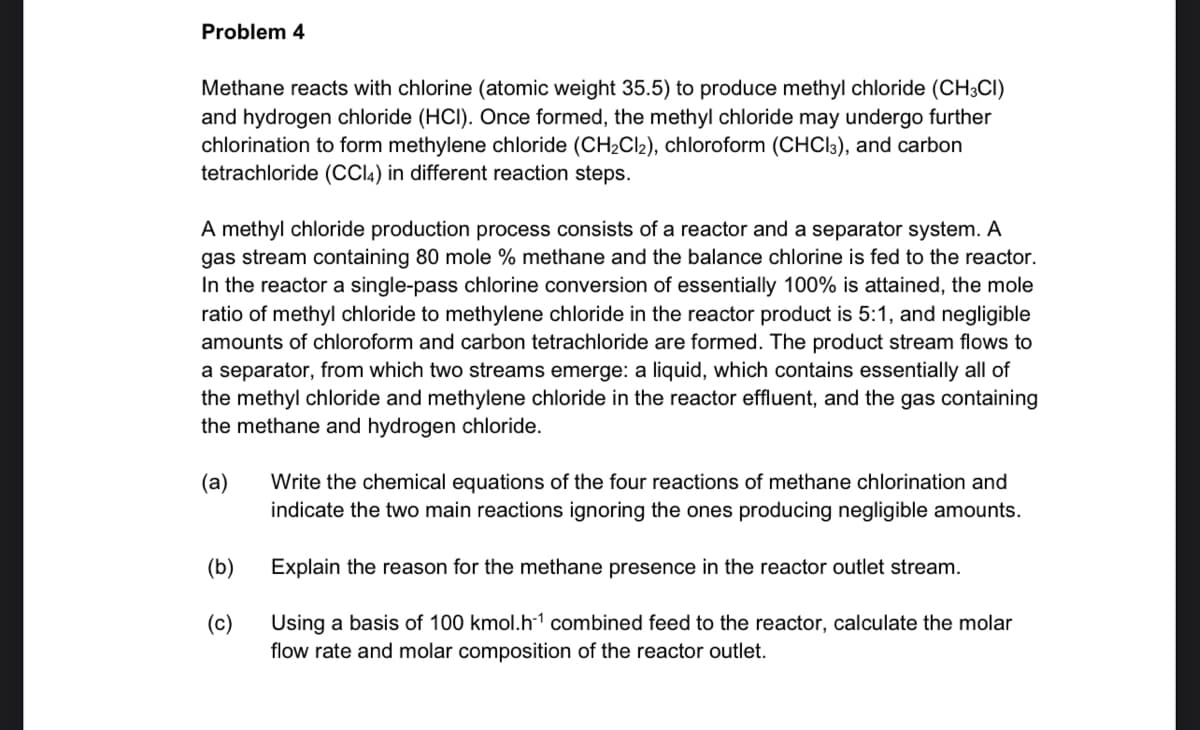Problem 4 Methane reacts with chlorine (atomic weight 35.5) to produce methyl chloride (CH3CI) and hydrogen chloride (HCI). Once formed, the methyl chloride may undergo further chlorination to form methylene chloride (CH2CI2), chloroform (CHCI3), and carbon tetrachloride (CCI4) in different reaction steps. A methyl chloride production process consists of a reactor and a separator system. A gas stream containing 80 mole % methane and the balance chlorine is fed to the reactor. In the reactor a single-pass chlorine conversion of essentially 100% is attained, the mole ratio of methyl chloride to methylene chloride in the reactor product is 5:1, and negligible amounts of chloroform and carbon tetrachloride are formed. The product stream flows to a separator, from which two streams emerge: a liquid, which contains essentially all of the methyl chloride and methylene chloride in the reactor effluent, and the gas containing the methane and hydrogen chloride. (а) Write the chemical equations of the four reactions of methane chlorination and indicate the two main reactions ignoring the ones producing negligible amounts. (b) Explain the reason for the methane presence in the reactor outlet stream. Using a basis of 100 kmol.h-1 combined feed to the reactor, calculate the molar flow rate and molar composition of the reactor outlet. (c)
Problem 4 Methane reacts with chlorine (atomic weight 35.5) to produce methyl chloride (CH3CI) and hydrogen chloride (HCI). Once formed, the methyl chloride may undergo further chlorination to form methylene chloride (CH2CI2), chloroform (CHCI3), and carbon tetrachloride (CCI4) in different reaction steps. A methyl chloride production process consists of a reactor and a separator system. A gas stream containing 80 mole % methane and the balance chlorine is fed to the reactor. In the reactor a single-pass chlorine conversion of essentially 100% is attained, the mole ratio of methyl chloride to methylene chloride in the reactor product is 5:1, and negligible amounts of chloroform and carbon tetrachloride are formed. The product stream flows to a separator, from which two streams emerge: a liquid, which contains essentially all of the methyl chloride and methylene chloride in the reactor effluent, and the gas containing the methane and hydrogen chloride. (а) Write the chemical equations of the four reactions of methane chlorination and indicate the two main reactions ignoring the ones producing negligible amounts. (b) Explain the reason for the methane presence in the reactor outlet stream. Using a basis of 100 kmol.h-1 combined feed to the reactor, calculate the molar flow rate and molar composition of the reactor outlet. (c)
Chemistry
10th Edition
ISBN:9781305957404
Author:Steven S. Zumdahl, Susan A. Zumdahl, Donald J. DeCoste
Publisher:Steven S. Zumdahl, Susan A. Zumdahl, Donald J. DeCoste
Chapter1: Chemical Foundations
Section: Chapter Questions
Problem 1RQ: Define and explain the differences between the following terms. a. law and theory b. theory and...
Related questions
Question

Transcribed Image Text:Problem 4
Methane reacts with chlorine (atomic weight 35.5) to produce methyl chloride (CH3CI)
and hydrogen chloride (HCI). Once formed, the methyl chloride may undergo further
chlorination to form methylene chloride (CH2CI2), chloroform (CHCI3), and carbon
tetrachloride (CCI4) in different reaction steps.
A methyl chloride production process consists of a reactor and a separator system. A
gas stream containing 80 mole % methane and the balance chlorine is fed to the reactor.
In the reactor a single-pass chlorine conversion of essentially 100% is attained, the mole
ratio of methyl chloride to methylene chloride in the reactor product is 5:1, and negligible
amounts of chloroform and carbon tetrachloride are formed. The product stream flows to
a separator, from which two streams emerge: a liquid, which contains essentially all of
the methyl chloride and methylene chloride in the reactor effluent, and the gas containing
the methane and hydrogen chloride.
(a)
Write the chemical equations of the four reactions of methane chlorination and
indicate the two main reactions ignoring the ones producing negligible amounts.
(b)
Explain the reason for the methane presence in the reactor outlet stream.
(c)
Using a basis of 100 kmol.h-1 combined feed to the reactor, calculate the molar
flow rate and molar composition of the reactor outlet.
Expert Solution
This question has been solved!
Explore an expertly crafted, step-by-step solution for a thorough understanding of key concepts.
This is a popular solution!
Trending now
This is a popular solution!
Step by step
Solved in 4 steps

Knowledge Booster
Learn more about
Need a deep-dive on the concept behind this application? Look no further. Learn more about this topic, chemistry and related others by exploring similar questions and additional content below.Recommended textbooks for you

Chemistry
Chemistry
ISBN:
9781305957404
Author:
Steven S. Zumdahl, Susan A. Zumdahl, Donald J. DeCoste
Publisher:
Cengage Learning

Chemistry
Chemistry
ISBN:
9781259911156
Author:
Raymond Chang Dr., Jason Overby Professor
Publisher:
McGraw-Hill Education

Principles of Instrumental Analysis
Chemistry
ISBN:
9781305577213
Author:
Douglas A. Skoog, F. James Holler, Stanley R. Crouch
Publisher:
Cengage Learning

Chemistry
Chemistry
ISBN:
9781305957404
Author:
Steven S. Zumdahl, Susan A. Zumdahl, Donald J. DeCoste
Publisher:
Cengage Learning

Chemistry
Chemistry
ISBN:
9781259911156
Author:
Raymond Chang Dr., Jason Overby Professor
Publisher:
McGraw-Hill Education

Principles of Instrumental Analysis
Chemistry
ISBN:
9781305577213
Author:
Douglas A. Skoog, F. James Holler, Stanley R. Crouch
Publisher:
Cengage Learning

Organic Chemistry
Chemistry
ISBN:
9780078021558
Author:
Janice Gorzynski Smith Dr.
Publisher:
McGraw-Hill Education

Chemistry: Principles and Reactions
Chemistry
ISBN:
9781305079373
Author:
William L. Masterton, Cecile N. Hurley
Publisher:
Cengage Learning

Elementary Principles of Chemical Processes, Bind…
Chemistry
ISBN:
9781118431221
Author:
Richard M. Felder, Ronald W. Rousseau, Lisa G. Bullard
Publisher:
WILEY